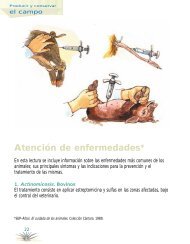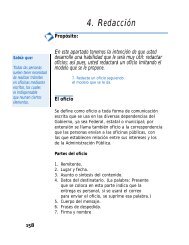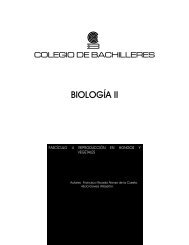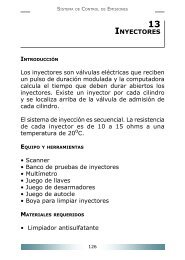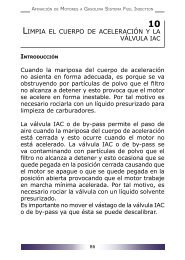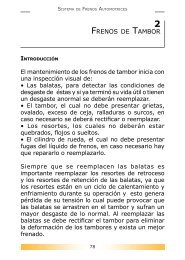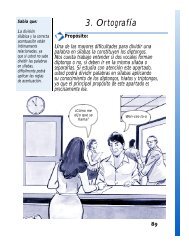- Page 1: COLEGIO DE BACHILLERES CÁLCULO DIF
- Page 4 and 5: CAPÍTULO 2. APLICACIONES DE LA DER
- Page 7: INTRODUCCIÓN El Cálculo Diferenci
- Page 11 and 12: Antes de iniciar el estudio de este
- Page 13 and 14: 1.1 LA DERIVADA CAPÍTULO 1 LA FUNC
- Page 15 and 16: Una bola sube verticalmente alcanza
- Page 17 and 18: 1.1.1 CONCEPTO DE DERIVADA Precisam
- Page 19: Graficando f (x) = x 3 - 4x - 5 con
- Page 23 and 24: Posición límite de las rectas sec
- Page 25 and 26: El cálculo diferencial es el estud
- Page 27 and 28: Observemos la gráfica. Gráfica No
- Page 29 and 30: 1.1.2 NOTACIÓN DE LA DERIVADA. Es
- Page 31 and 32: 2) DERIVADA DE LA VARIABLE INDEPEND
- Page 33 and 34: 2 3 Ejemplo. Calcula y’ si y = (
- Page 35 and 36: Ejemplo. Considerando otra vez la e
- Page 37 and 38: 1. Usando la regla del producto cal
- Page 39 and 40: Ejemplos. Derivar: y = x −6 39 3
- Page 41 and 42: y = x 1/ 2 1 + x 1/ 2 = x 1/ 2 + x
- Page 43 and 44: dy dx du = f '( u) y = g'( x) dx Co
- Page 45 and 46: Contesta las siguientes preguntas c
- Page 47 and 48: Ejercicios de aplicación. 4 2 a) S
- Page 49 and 50: 1. Calcula f ’ , f ’’ y f ’
- Page 51 and 52: Ejemplo. Derivar 5x + y 2 2 − xy
- Page 53 and 54: d) El numero “e”; se utiliza en
- Page 55 and 56: f) DERIVADA DE ln u log u se puede
- Page 57 and 58: Ejemplo. Derivar 3 x y = e donde u
- Page 59 and 60: c) DERIVADA DE LA FUNCIÓN TANGENTE
- Page 61 and 62: Derivar: ( x) f = 7sec x 3 y ´ = 7
- Page 63 and 64: 1.2.7 DERIVADAS DE FUNCIONES TRIGON
- Page 65 and 66: Para las derivadas de las funciones
- Page 67 and 68: cos y y’ = u’ despejamos y u' c
- Page 69 and 70: despejando u′ = sec y ′ (1) y 2
- Page 71 and 72:
2 2 como tan y = sec y −1 y tan y
- Page 73 and 74:
FUNCIÓN DERIVADA A TRAVÉS DE LA R
- Page 75 and 76:
Para la solución de los problemas
- Page 77:
CAPÍTULO 2 APLICACIONES DE LA DERI
- Page 81 and 82:
CAPÍTULO 2 APLICACIONES DE LA DERI
- Page 83 and 84:
La gráfica queda como se muestra a
- Page 85 and 86:
Observa la gráfica y analiza las s
- Page 87 and 88:
1. Para cada una de las funciones s
- Page 89 and 90:
Al graficar la función se pueden a
- Page 91 and 92:
1. Para cada una de las funciones s
- Page 93 and 94:
Ahora, observa nuevamente la gráfi
- Page 95 and 96:
Observa la tabla y la gráfica para
- Page 97 and 98:
Completa la siguiente tabla t P(t)
- Page 99 and 100:
y y c) d) c) Criterio de la Primera
- Page 101 and 102:
En un laboratorio de investigacione
- Page 103 and 104:
y como es un valor positivo de la d
- Page 105 and 106:
2.1.4 PUNTOS DE INFLEXIÓN Para la
- Page 107 and 108:
Por lo que el punto de inflexión s
- Page 109 and 110:
2. Para cada una de las siguientes
- Page 111 and 112:
a) para la ecuación de la recta ta
- Page 113 and 114:
2.3 PLANTEAMIENTO Y RESOLUCIÓN DE
- Page 115 and 116:
Planteamiento. El recipiente tiene
- Page 117 and 118:
Y, al igualar a cero, queda que −
- Page 119 and 120:
Planteamiento Como el aire escapa a
- Page 121 and 122:
Contesta las siguiente preguntas co
- Page 123 and 124:
Al sustituir t = 1.633 en ´h (t)´
- Page 125 and 126:
10) Se lanza verticalmente hacia ar
- Page 127 and 128:
La derivada nos permite resolver to
- Page 129 and 130:
ACTIVIDADES INTEGRALES Con el objet
- Page 131 and 132:
Compara las respuestas que obtuvist
- Page 133 and 134:
LÍMITES 3.1 LÍMITE DE UNA FUNCIÓ
- Page 135 and 136:
Como ya has visto, la derivada es u
- Page 137 and 138:
3.1 LÍMITE DE UNA FUNCIÓN CAPÍTU
- Page 139 and 140:
ACTIVIDAD DE REGULACIÓN Observa la
- Page 141 and 142:
Estos resultados apoyan la conjetur
- Page 143 and 144:
Recordemos que x 5 lim → f(x)=400
- Page 145 and 146:
Elabora una tabla en donde se muest
- Page 147 and 148:
Ahora puedes calcular los valores d
- Page 149 and 150:
3.1.3 CASOS EN LOS QUE EL LÍMITE N
- Page 151 and 152:
Indica si existe el límite en cada
- Page 153 and 154:
3.2 CONTINUIDAD Al estudiar los cua
- Page 155 and 156:
Precisemos un poco más, aunque de
- Page 157 and 158:
2) ¿Existe f (a)? ________________
- Page 159 and 160:
Contesta las siguientes preguntas.
- Page 161 and 162:
f(x) 20 -3 0 3 f(x) 140 -1 0 1 2 3
- Page 163 and 164:
¿Qué observaste? ________________
- Page 165 and 166:
10 -10 -1 10 -5 -4 -3 -2 -1 -10 10
- Page 167 and 168:
Realiza las siguientes actividades:
- Page 169 and 170:
Los resultados obtenidos por medio
- Page 171 and 172:
Continuidad de las Funciones Racion
- Page 173 and 174:
c) Propiedades de los Límites Ya e
- Page 175 and 176:
El segundo miembro de la igualdad a
- Page 177 and 178:
e) f) -1 0 1 2 3 -1 80 -10 y 10 f/g
- Page 179 and 180:
Límite de una Potencia y una Raíz
- Page 181 and 182:
3.2.3 LOS LÍMITES Y EL INFINITO a)
- Page 183 and 184:
Observa que hay otros casos en los
- Page 185 and 186:
c) Límite de una Función Cuando l
- Page 187 and 188:
¿Cuál es la ecuación de la asín
- Page 189 and 190:
e) Límites de Algunas Funciones Tr
- Page 191 and 192:
−0. 02t Para obtener lim( x e ) ,
- Page 193 and 194:
Por otra parte, si m → ∞, h →
- Page 195 and 196:
El valor de d depende del valor del
- Page 197 and 198:
EXPLICACIÓN INTEGRADORA En este te
- Page 199 and 200:
5. Sea f una función definida en u
- Page 201 and 202:
18. Si un monto P es invertido a la
- Page 203 and 204:
) Bosqueja la gráfica de la funci
- Page 205 and 206:
c) Asíntota vertical x = 1; asínt
- Page 207 and 208:
Realiza los siguientes ejercicios.
- Page 209 and 210:
8t + 1 c) lim t→1 t + 3 d) 3 lim
- Page 211 and 212:
3. a) 3 f '( x) = , 2 3x + 1 f '( x
- Page 213 and 214:
3. Un paciente recibe una dosis ini
- Page 215 and 216:
215








